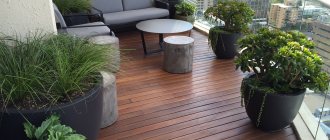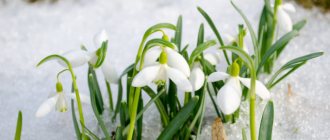On any summer cottage there is a place that is in the shade most of the time (whether it is a place behind the house, a bathhouse, or near a fence from which the shadow falls). As you know, most plants love sunlight. But there is a way out; in such a place you can plant flowers that love shade.
Vegetables, berry bushes and fruit trees need the sun, because thanks to it they grow. If a gardener wants to get a good harvest, then planting these plants in the shade is not an option, and you don’t want to leave this place empty.
Of course, any plant needs sunlight, because this is the basis of their life (light is necessary for photosynthesis), but some types of plants have learned to do without direct sunlight.
It is believed that beautiful flowers cannot grow in the shade, but this is a popular misconception. Many luxurious flowers do not like direct sunlight. With the help of such plants that prefer shade, you can create extraordinary landscapes built on the play of light and shadow that will amaze the imagination and attract people to themselves.
On a hot summer day, it will be nice to sit in the shade next to such a flowerbed and enjoy the coolness.
Primrose
Wonderful low-growing perennial primrose and its hybrids thrive in the shade. They can grow at the front edge of the flower bed, in the shade of taller, sun-loving flowers. The height of shade-loving primroses is 10 - 20 cm, of various colors. The most interesting types of primroses to grow are auricular ones. Its flowers are double, with various rims. Primrose is difficult to grow at home from seeds, so most often they propagate by dividing old bushes, or purchase new ones. This flower is one of the first to bloom in the garden and delights with its flowering from April to May.
Lungwort
These flowers that love shade are familiar to many from childhood. It is the one that grows in the shade of the forest, and if you taste the bed of the peduncle, it will taste sweet. This is where the name of this color comes from. The leaves of this plant have white spots, the flowers change color from pink to blue. There are varieties with whole green leaves and varied flower colors. Plant height is 30 - 40 cm. It can grow strongly and is classified as ground cover flowers, since the flowers can bush a lot. Lungwort is divided and replanted once every 3 years. Refers to spring flowering plants. Flowering time: April - May.
Shade-loving and shade-tolerant flowers - what's the difference?
There is a division into shade-loving and shade-tolerant plants. Unfortunately, many gardeners confuse these two concepts due to the similarity in name, but it is imperative to understand their features. So how are they different from each other?
The main difference between these two types of plants is that shade-loving plants do not tolerate direct sunlight at all, trying to grow somewhere in the least lit places, and shade-tolerant plants prefer semi-dark places where sunlight penetrates limitedly.
Shade-loving plants can easily cope with the complete absence of direct sunlight, while shade-tolerant plants grow in dimly lit areas.
Before you start choosing flowers, you need to decide how much light gets into the flowerbed during the day, whether it will be a constant shadow, where, for example, due to the construction, sunlight never reaches, or whether there will be light only in the mornings (evenings) . Only after this can you begin to carefully select colors.
We should also not forget that most plants growing in the shade love moist soil, which they definitely need to create. However, excessive waterlogging should be avoided, as this can cause the development of various diseases. Moisture in the shade takes several times longer to evaporate than in areas exposed to the sun. In addition, it is necessary that there is space between the plants, since air circulation is necessary.
Don’t forget about the soil, it should be nutritious and light. An important feature of a shady area with moist soil is the presence of slugs and snails, which must be removed from the plants.
Flowers that can grow in the shade are usually divided into two groups: perennials (there are quite a lot of them) and annuals.
Rogersia
It is similar to ornamental rhubarb and can grow in a shady, moist border. The leaves are palmate on long petioles, the flowers without petals are collected in fluffy panicles. It is a perennial and is propagated by dividing bushes in spring or autumn.
These are tall flowers that love shade in the garden, growing up to 1.8 m in height, compact plants up to 1 meter. An excellent plant for decorating country fences and buildings.
Tips for caring for Rogers:
- water abundantly during drought;
- In autumn, cut at the root.
Smilatsina
A border perennial with arched stems crowned with racemes of tiny star-shaped flowers. Fragrant flowers are often replaced by red berries. This is a plant for a wooded corner of the garden that is best left undisturbed. And if you are deciding which flowers grow in shade, and forest-like shade, it is definitely smilacina, which grows quickly, forming beautiful ornamental bushes and creating a soulful landscape design for the area.
The height of the flowers is 60 - 90 cm. The best species for growing in the garden is Smilacina racemosus, which forms large bushes. Flowering period from May to June.
Tips for caring for smilacina:
- shading is required;
- in spring the soil needs to be mulched;
- propagated by dividing bushes in spring.
Video description
About shrubs for shady corners of the garden in the following video:
Deciduous
There are many proven plants that are resistant to the Russian climate and lack of sun. These include the following types:
- Barberry. The shrub is unpretentious to the soil and is not afraid of winter frosts. Breeders have bred several dozen varieties. Common barberry has decorative fragrant yellow flowers, bright red berries and leaves, which acquire a rich purple color in autumn. Other varieties have bright purple (Thunberga barberry) or golden yellow (Thunberga Goldalita barberry) foliage throughout the season.
Barberry Source maja-dacha.ru
- Euonymus. Deciduous or evergreen varieties have a beautiful openwork crown, which is valued for its autumn attire. By autumn, the leaves turn a variety of shades: from white and yellow to red-orange, pink and burgundy. Low variegated forms with leaves bordered by a light stripe look good. Fruits of unusual shape are also decorative; bright red or purple berries decorate the plant until frost sets in.
Euonymus in autumn Source media.pennlive.com
- Derain is white. Perfectly refreshes a shaded area thanks to its decoratively colored leaves with an expressive white border along the edge. The leaves do not lose their color in the shade, and in the fall they acquire additional pink-apricot shades. An additional plus is that bright red shoots will decorate the winter garden. Derain is frost-resistant and unpretentious, but it needs moist, fertilized soil. Some varieties grow up to 2-2.5 m, but tolerate pruning well, so it is quite easy to control the size and shape.
White dogwood Source greengarden31.ru
- Japanese spirea. It pleases gardeners with its varietal diversity: plants can vary greatly in size and shape of the bush. What’s nice is that the flowering periods are also different, from spring-flowering to summer and those varieties that please the eye until the coldest weather. Some varieties have leaves that are golden yellow, orange, or lemon-colored, allowing them to compete with other flowering shrubs. Numerous flowers (white or pink) are excellent honey plants.
Japanese spirea Source www.botanichka.ru
- Rowan-leaved fieldfare. It is successfully used in the landscape design of a private area as an ornamental shrub for shady places. The reason for its popularity is its exceptional unpretentiousness and elegantly shaped leaves, which in the fall become exceptionally bright, orange-red. In some varieties, young foliage is painted bright yellow-orange with purple. With the onset of summer, the rich shades do not disappear, remaining on the growing young shoots.
Rowan-leaved fieldfare (left) Source classpic.ru
Tiarella
Above the wintering leaves, which turn bronze or red in the fall, racemose inflorescences of small fluffy flowers rise in the summer. Grows well under trees.
Perennial. Flowering time depends on the species. Tiarella Verri blooms from June to September and does not spread. Tiarella multifolia blooms in May - June. According to the duration of flowering, these are long-blooming flowers. The height of the plants is average, 30 - 50 cm. These garden flowers, blooming in the shade, do not tolerate direct sun and lack of moisture.
There is one feature for all flowers in the shade - all shade-loving flowers need to be planted on humus-rich soil.
Shade and partial shade on the site
The area that requires special attention may be in shade or partial shade. Many perennials are shade-tolerant, meaning that they can tolerate shade as long as they are exposed to sunlight for some time, preferably in the morning or evening. There are not so few such plants.
A much bigger problem is posed by areas where there is shade from spring to autumn. Agree, planting bulbous perennials or primroses under trees and admiring them for a month and a half is not enough. Places where shade dominates should also look attractive throughout the year.
The biggest problem associated with the choice of perennials for shade or partial shade is faced by the owners of vast lands, who initially designed part of the territory as an imitation of a natural forest corner. Firstly, flower beds and ridges would be out of place there, and secondly, you still want the “wild” corner to be attractive. Thirdly, no matter what the wealth of the owners, it is still expensive to plant a large tract of expensive perennials for shade and partial shade. But there are plants growing in the shade that grow quickly, do not require care, and look picturesque when planted in large tracts.
Dicentra
An excellent border perennial and rock garden perennial with a plant height of 30 cm. Wonderful medallion flowers hang from arched peduncles above the feathery foliage. These shade flowers need a protected place to grow: young leaves suffer from cold winds. These flowers can be planted in the shade of trees. Flowering time is from May to June. Color: pink, pinkish-lilac, red.
Dicentra care advice:
- The roots of the plant do not lie deep, so the soil around the stems is not loosened.
Khosta
Hosta is grown for its gorgeous foliage. These are decorative leafy garden flowers in the shade - the pride of any gardener. The foliage has longitudinal stripes of yellowish or white color, bluish-green. Hosta blooms in paniculate inflorescences, with numerous bell-like flowers that bloom in June - August. Grows well in partial shade, under trees. Belongs to border perennials.
Propagated by dividing bushes and nests in the spring. Plant height 50 cm.
Hosta care tip:
- add organic matter before planting;
- the soil where the hosta is planted should be well-drained;
- protect the plant from slugs.
Hosta or funkia
This plant is more attractive not for its flowers, but for its spectacular leaves that decorate the garden throughout the season. Hosta Siebold's leaves are bluish-green, wrinkled, and in July delicate, light purple flowers appear on the plant, however, after 2 weeks they fade.
Hostas such as small, narrow-leaved, plantain, wavy, and Fortune feel good in shady gardens. These plants, even in adulthood, do not take up much space, so they are also suitable for rock gardens. There they can be safely planted on the shady side.
At first, botanists classified the hosta as a member of the Liliaceae family, but, according to the new classification, this plant belongs to the Hostaceae family.
Violet
There are different types of violets, which are also called pansies. But, if you are choosing a list for the garden, from the category of which flowers bloom in the shade, then you need a perennial violet. This:
- Fragrant violet Viola odorata - 10 - 15 cm. White or blue color. Fragrant. Flowers with a diameter of 2 cm. Blooms in May.
- Horned violet Viola cornuta - 20 cm. Lilac. Blooming all summer from May to September.
- Labrador violet Viola labradorica - 10 cm. Violet - blue. Blooms in spring and early summer.
- Yellow violet Viola lutea and two-flowered Viola biflora - 10 cm. Yellow. Blooms in May - June.
Perennial violets definitely need shade. Faded inflorescences should be removed regularly. The plant is protected from slugs. During drought, watering is necessary.
Phloxes
There are perennial and annual phloxes. And both types are the kind of flowers that love light shade. They bloom profusely in the second half of summer. Dwarf perennial phlox species are grown in rock gardens.
Phlox blooms in inflorescences of small bell-shaped flowers, the total size of the inflorescences reaches 10 cm in diameter. Flowers with rounded or pointed petals. More popular modern varieties such as Phlox Drummond 'Tapestry Mixed' are more compact and more vibrantly colored than older varieties. The height of perennial plants is 50 - 80 cm, annual phlox reaches 20 - 50 cm.
Phlox care:
- when planting, add organic fertilizers to the soil;
- in spring, the soil around the bushes is mulched;
- if necessary, tie up the stems;
- water moderately;
- at the end of autumn, perennial phloxes need to be cut off at the root.
Shade-tolerant annual flowers
Many beautifully blooming annual flowers will adapt to dappled to partial shade if given 4-5 hours of sun in the morning and evening. In some shade-tolerant flowers, the corolla remains brightly colored, while in others it becomes paler. Shade-tolerant annuals that bloom throughout the warm season, unlike shade-loving ones, grow well in the sun.
Cosmea
The unpretentious, shade-tolerant annual retains cheerful colors everywhere: white, pink, purple in the double-pinnate cosmos, bright orange and yellow in the sulfur-yellow. Different varieties have been bred that differ in plant height and petal border, semi-double and with a corolla up to 12 cm in diameter. On fertile soils and with sparse planting, more green lacy mass is formed than flowers; tall varieties rise to 120-160 cm.
Shade-tolerant cosmos grows on fertile and relatively poor, loose soils and tolerates drought. Sown in the garden in May-April, blooms from July until frost. The shade-tolerant annual is also grown as seedlings, planted in May. Cosmea reproduces successfully by self-sowing, and the sprouts are also transplanted. Samoseykas bloom earlier - from the second ten days of June.
Attention! Rich flowering of cosmos is ensured by timely removal of faded heads.
Marigold
Brightly flowering annuals are sun-loving, but also shade-tolerant. There are 3 common types: erect, low-growing, thin-leaved. The height of the flowers varies from 20 to 130 cm. Marigolds develop well on fertile loams and require abundant watering at the beginning of growth. Seeds are sown in the soil when it warms up to 15 oC. Shade-tolerant plants bloom from July until the end of the warm season.
For flowering, seedlings are grown in June and transferred to the garden when the threat of frost has passed. Erect or African marigolds are tall, with double flowers in warm colors ranging from orange and yellow to creamy white. Shade-tolerant marigolds grow up to 20-60 cm, come with full inflorescences and simple ones. The colors are enriched with deep red-brown shades. Fine-leaved marigolds have bright red-orange and golden colors. This, still quite rare species in our gardens, has beautiful openwork foliage.
Lobelia
These annual flowers develop well in diffuse shade, as well as in the sun. Compact spherical bushes 10-20 cm in height, with small, up to 1.5-2 cm flowers in white and blue tones, some blue, violet, purple. Blooms from May to September.
The shade-tolerant annual, which blooms all summer, reproduces by seedlings: the seeds are sown from the beginning of February in a substrate of coconut fiber, sand, or garden soil. Small grains are laid out on the surface, lightly sprinkled with sand so that the moisture does not evaporate so quickly. Watering is regular, and the temperature is not higher than 20 °C. The first month the sprouts develop slowly. After two months, 2-3 seedlings are planted in pots. When shade-tolerant plants rise to 6-7 cm, they are pinched for splendor. Plant in loam or sandy loam and water abundantly.
Nasturtium
A good annual for shade that blooms all summer is nasturtium. This is an unpretentious, drought-resistant plant. Young bushes are watered abundantly. In the dense shade you may not be able to wait for flowering, but the leaves are lush and beautiful and are used in salads. Low-growing shade-tolerant plants rise up to 20-50 cm, decorated with large corollas up to 5 cm in diameter. Warm colors - yellow, orange, red, crimson, and sometimes fawn. Climbing nasturtium, up to 3 m, requires a sunny place.
The seeds are planted in the spring on the site, deepening it into the soil by 2-3 cm, when the warmth finally sets in, in the middle or end of May. When propagating seedlings in April, they are sown in separate pots, because the root system is weak and superficial and is easily injured. Shade-tolerant plants love slightly acidic, light soil and potassium-phosphorus fertilizers before flowering.
Sweet tobacco
Fragrant evening plants from 20 to 90 cm in height depending on the variety, blooming in shades of crimson, pink, and white. Shade-tolerant flowers up to 4-8 cm in diameter, open from June to October. Planted in partial shade on light loams, they provide moisture; tobacco does not tolerate drought well. Planted once, it spreads by self-seeding, but blooms later.
Seeds are sown in March and early April, only lightly covered with substrate. They are planted in separate containers when the second leaf appears. Move to the flowerbed at the end of May.
Astilbe
Feels great in light partial shade on the site. Requires fertile soil. Therefore, before planting astilbe, you need to add organic matter. Spectacular paniculate inflorescences can be left on the bush until autumn. Pinnately dissected leaves often take on a copper tint in spring. During drought, plants need to be watered. There is a drought-resistant species - this is Chinese astilbe.
A fairly tall plant - 90 cm, can grow in the background or middle ground of a flower bed. Used as a border perennial and rock garden perennial. These flowers need to be planted in the shade.
Berry bushes for dimly lit areas
A large number of varieties of berry bushes with sweet fruits are suitable for planting in dimly lit areas. Shade-loving plants appeared due to the fact that in the natural environment, blackberry, raspberry, rowan, honeysuckle and viburnum bushes grew in the forest, under the cover of treetops.
You can plant berry bushes in the shade of your house to get juicy fruits throughout the summer.
Blackberry
The blackberry bush can be planted in the shade of a tree or fence; it is unpretentious in relation to sunlight, but requires good watering.
If you water the blackberries abundantly after planting and fertilize the soil with organic substances, such as pine ash, the bush will produce a large number of fruits.
Shade-grown blackberries will ripen slightly later than sun-grown blackberries, but the size and flavor of sun and shade berries will be the same.
Raspberries
The raspberry bush grows well and bears fruit in poorly lit areas of the garden or vegetable garden. It can be planted along the fence, in the shade of grapes or fruit trees.
Raspberries ripened in the shade are juicier, larger and sweeter than those grown in a well-lit place.
Currant
Currant bushes can not only be grown in shady areas, but are even necessary, since a bush planted in the sun in the southern regions will burn. Currants love shade, as in the wild they grow in fairly dark and swampy areas.
In partial shade, large and sweet red currant berries will grow on the bush, but they will ripen a little slower than on bushes planted in a well-lit place in central Russia.
Kalina
Light-loving viburnum shrubs can be grown in partial shade, as they will not die from lack of light. However, lack of sufficient sunlight will cause the volume of crops on the branches to decrease.
In a shaded area, viburnum will turn from a fruitful plant into a decorative one.
Rose hip
In addition to the fact that rosehip blooms beautifully, its fruits are very beneficial for health. You can plant shrubs in shady areas of the garden, as they easily adapt to low amounts of sunlight.
Note: during flowering, rose hips attract bumblebees to the site, which are an important part of the ecosystem and are useful for the garden and greenhouses.
Snowdrop
Bulbous primrose. Small graceful flowers are the harbingers of spring. It blooms in early spring, one of the first in the garden, in April - May.
The snowdrop is similar to the whiteflower, but it has three inner "petals" with green tips, and the outer three are pure white. A low-growing flower, about 15 - 20 cm in height. Loves humus-rich soil and light shade. These lovely flowers need to be planted in the shade.
Annual shade-loving flowers for the garden
Shade-loving annuals with dense, green foliage are planted in corners with diffused light.
Balsam
Shade-loving balsam can be used indoors or in gardens. Sometimes domestic perennial species are found in flower beds. A beautifully flowering shade-loving annual with a corolla, which differs from indoor plants, is planted in partial shade. They provide fertile, light soil, which is loosened and watered, and fed with mineral complexes until buds.
Seeds are sown in March and moved to the garden at the end of May-June. Flowering seedlings have been coloring the area since June. They are also sown in the garden; flowers appear from August to autumn. The palette of petals is varied: red, pink, purple and white shades.
Begonia
Typical annual flowers that grow in the shade are ever-blooming begonias. From low, 15-20 cm, shade-loving plants, designers create spectacular bedspreads in flower beds. The flowers of different varieties are white, pink, crimson, red, orange, yellow; simple and terry. Flowering varieties differ in the shape and color of the leaves - green or bronze. The shade-loving crop grows on fertilized and moist soils and requires regular watering. Blooms from June to October.
They are planted as seedlings, the seeds are sown very early, at the end or even mid-January in a poorly nutritious substrate. The seedlings develop slowly at first and look weak. They dive in a month and a half. They are moved to the flowerbed from the end of May. After transplantation, they are fed with nitrogen preparations for lush growth. Fertilize with mineral complexes with low nitrogen content before bud formation and flowering. Drip irrigation is used for begonias.
Saxifrage
Modest, unpretentious flowers of bright color in the shade-loving saxifrage, 20-30 cm high. This annual prefers dry, shady places. The soil is suitable: ordinary, garden, light. On heavy soils, drainage must be provided, since the shade-loving annual does not tolerate stagnant water. Feed once a month along with watering with mineral fertilizers, excluding nitrogen fertilizers.
Saxifraga is sown in early spring in boxes, which are placed in the cold for 15-20 days so that the seeds undergo stratification. Small grains are sprinkled with sand. The seedlings are transferred to the garden in June. Seeds are also sown immediately after the snow melts. Under such conditions, natural stratification takes place. The annual shade-loving saxifrage blooms in July and decorates the garden until autumn. They sell a multi-colored mixture of pink, light red and white shades.
Calceolaria
Sometimes shade-loving indoor flowers with cheerful colors are planted in the garden for the summer. But more unpretentious flowering species are popularized as garden crops. Shade-loving Mexican calceolaria or rugose calceolaria, a flower native to Chile, is placed near the stream, under the trees. Bright annual shade-loving flowers need fertile soil, organic matter, and watering. To get flowering from May, they are grown as seedlings. When sowing seeds in the garden, you admire the bright blooming lanterns on the plants from June to autumn.
The corollas of both shade-loving species are light yellow. Calceolaria Mexicana, 20-50 cm high, with beautiful small flowers up to 5 mm in diameter, which enliven shady areas. The Chilean species is the same height, but the flowering corollas are larger - up to 1.5-2 cm. Some hybrids have decorative brown dots on yellow petals.
Mimulus
Also suitable for a coastal zone or marshy area are low-growing, shade-loving annuals that bloom all summer, such as mimulus. Popularly, expressive flowers that reach a diameter of 5-8 cm are often called lipsticks for the shape of the petals. The bushes rise up to 20-30 cm. They are placed in border plantings, on ridges that are located on the north side. Shade-loving plants develop best in moist, fertile soil, which is regularly loosened. Feed with complex fertilizers.
Grow by seedlings: seeds are sown in April, without covering with soil. After two months, the seedlings are transferred to a permanent place. Flowers decorate the site all summer. The shade-loving plant produces colorful buds regardless of the amount of sunlight it receives. Then the shoots are pruned, stimulating the appearance of a new wave of flowering, which continues until late autumn. This beautifully flowering annual can withstand early frosts down to 3°C. The corollas are bright, with stripes and strokes.
Strawberries
A shade-loving groundcover plant grown for its flowers and berries. The characteristic trifoliate leaves can decorate a shady garden and create an atmospheric corner.
Strawberries grow quickly and can choke out weaker plants. It blooms in May - June, and the delicious and fragrant berries ripen at the end of June - July. Suitable for creating a herb garden. Plant height 10 cm - 20 cm.
catchment area
Traditional columbines have white or blue flowers with short spurs. Nowadays varieties with long spurs, double varieties, and also dwarf ones for rock gardens have been bred.
These are flowers that love shade and bloom in the shade in the first half of summer, from May to June. For long-term flowering, you need to remove faded flowers and water abundantly during drought. They grow well in constantly moist and shady places.
They reproduce by seeds, which can be sown directly into open ground in the spring or by dividing overgrown perennial bushes.
Coniferous trees
In the shady part of the plot, in addition to flowers, vegetables, shrubs and fruits, you can grow several varieties of coniferous trees, which are completely easy to care for.
In shade and partial shade you can plant:
- spruce;
- yew;
- thuja;
- fir
Thuja grows equally well both in the sun and in partial shade, but if you plant the tree in deep shade, its crown will begin to thin out.
Day-lily
Blooming in light shade, these flowers appear in midsummer, above rosettes of strap-shaped leaves on long stalks. Each flower lives only 1 day, but the flowering communication of the plant continues for many weeks.
An unpretentious, easy to grow plant. Requires watering during drought, can grow along the banks of reservoirs and along the house. Plant height is 90 cm. Flower color is yellow, orange, dark red. A perennial plant that reproduces by dividing bushes.
Shadow intensity
Each area is illuminated non-uniformly. The following shadow areas are distinguished:
- scattered - from the foliage of trees through which the sun's rays pass;
- dense – often created by leafy trees;
- partial – the sun hits here for a while;
- stable - or deaf, located on the north side of buildings, fences, dense planting of conifers.
Shade-loving and shade-tolerant annuals can grow in deep and dense shade, but without flowers. For flowering annuals, areas with partial and diffuse shade are most suitable. Many shade-tolerant annual flowers benefit from partial shade, especially in the middle of the day.
Important! Lightly shaded areas are enlivened by shade-tolerant and shade-loving annuals with white and yellow flowers: cosmos, lobelia, calceolaria, mimulus, fragrant tobacco, asters (Callistephus chinensis).
Begonia everblooming and begonia species with tubers
Begonia is an ever-blooming plant, usually grown as an annual that grows well in partial shade. The color of the round, fleshy leaves varies from pale green to chocolate brown. The size of flowers can vary from 2 to 15 cm. Color from white to almost black. When planting begonias, add compost to the beds. Planted at the end of June (not in May!) Begonia blooms, which loves shade from June to September.
What plants can be grown in the shade?
Not all varieties of vegetables, herbs and fruits can be grown in the shade. For example, cabbage requires a lot of light, and if it is planted in the shade of a greenhouse or fence, it will be weak and will not be able to develop as it should. The same applies to carrots and potatoes: in an area without sufficient lighting, the tops will stretch out in an attempt to find light, and the root part will remain undeveloped. Peas can be planted in partial shade, but so that the shadow covers the vegetables only during the hottest time of the day. Arugula and dill will wilt and begin to shrink if they are not exposed to sunlight for 6-7 hours during the day.
In the shade in the garden you can plant plants such as cucumbers, beets, garlic, parsley, wild garlic, beans and much more.
Tomatoes, zucchini and pumpkins can be planted in a semi-shady area with diffused light, but they require more careful care and the size and number of fruits will most likely be slightly smaller than vegetables grown in the sun.
Greenery
Spicy herbs, such as basil, which came to Russia from the warm south, will not be able to grow in the shady areas of the dacha. However, in the shade you can plant less whimsical greenery, namely:
- cilantro;
- mint;
- parsley;
- thyme;
- lemon balm;
- celery;
- tarragon.
You may be interested in: Planting tomato seeds
If herbs and greens were planted under fruit trees or fruit bushes, then when treating the plants with chemical or organic agents to repel or control pests, the greens should be covered with a protective film. Even organic solutions will not be useful for edible greens, as they will affect the taste.
Onion
Not all varieties of onions can grow in shade or partial shade. Perennial plants, such as onions and chives, can be planted in a low-light area of the dacha without fear of not getting a harvest; moreover, perennial onions can grow thickly in the shade for more than one season.
Chives are easy to care for and have an extraordinary ability to spread throughout the area. After a couple of seasons, the plant can grow throughout the garden without any effort from gardeners. In addition, the onions are beautiful, more like flowers with lilac inflorescences that attract beneficial pollinating insects to the site. The abundance of insects contributes to the proliferation of not only perennial onions, but also all neighboring vegetables and herbs.
Slime onions begin to sprout with the arrival of early spring and are one of the first crops suitable for consumption as food.
Beans
Legumes are light-loving and rarely germinate in shady areas, but there is a variety of beans that can grow in partial shade.
Bush beans are recommended to be grown on a plot of land under fruit trees such as an apple or pear tree. Diffused light will allow the bushes to grow luxuriantly and bear fruit no worse than in a sunny area of the garden.
After harvesting beans before autumn, experienced gardeners recommend not cutting off the green tops, but leaving them on the site as fertilizer to enrich the soil with useful substances.
Beet
The sweet root vegetable beets can grow unhindered in dark areas of the garden; even a small amount of light will be enough for the vegetable to grow to a medium size.
However, it will not be possible to grow large beets in the shade; with a small amount of light, the root crop will be small, but soft and tender, more suitable for cooking.
Note: you can grow root parsley and parsnips in the shade using the same principle.
cucumbers
Vegetables such as cucumbers are light-loving, but breeders have developed several varieties that are able to develop normally and grow in partial shade, namely:
- Arina;
- Master;
- Danila;
- Company's secret;
- Moscow Nights.
These varieties of cucumbers grow well in indirect light, so it is best to plant them in beds in the shade of fruit trees or near massive bushes. Seedlings planted in partial shade will be able to bear fruit for much longer.
Cucumbers that grow in shade or partial shade are late bloomers.
Garlic
One of the most unpretentious plants is garlic; it grows in almost any area. A bed of garlic can be planted in the shade of trees, placed between flowers or shrubs.
The only consequence of a shady place for the garden bed is that the head of garlic will change slightly and may decrease in size, but this will not affect the taste of the vegetable in any way.
Horseradish
Even an area with dense shade is suitable for growing horseradish, since the plant is unpretentious in care and can survive in almost any conditions. Moreover, an area in the shade is even more favorable for lush growth than a sunny area.
The only thing to avoid is overwatering, since horseradish is not a vegetable that loves both shade and moisture. Slightly dry soil and hot summers are favorable conditions for horseradish growth.
Salads
The most environmentally adaptable plants include almost all types of head and leaf lettuces. In the shade, where sunlight falls on the area for 2-3 hours a day, you can grow:
- watercress;
- lettuce;
- spinach;
- chard.
You can plant sorrel and mustard nearby.
In well-lit areas, plant leaves grow too quickly, causing them to become coarse and may taste bitter. In the shade, the lettuce will grow more slowly, its leaves will not be very large in size, but they will remain soft and juicy for a longer time.
You may be interested in: Planting strawberries with seeds for seedlings
Cheremsha
The plant that combines the taste of garlic and onion is called wild garlic. In the natural environment, “bear onion” can be found in forests, where the plant grows under the canopy of massive trees.
Ramson can be generously sown in shady areas along the fence, behind the house or under the dense crown of fruit trees. The plant does not require special care and can be used not only as food, but also as a garden decoration, as it blooms with delicate white flowers.
Rhubarb
You can grow rhubarb in the shade, as it is one of the vegetables that like low-light areas of the ground with a lot of moisture.
Rhubarb can be planted in autumn or spring through seeds, but then the growth process will take a lot of time (from 1 to 2 years).
If you plant rhizomes in a shady area, the rhubarb will grow faster. The bush will quickly take root, which means it will gain mass, and its stems will become dense, strong and juicy.
Strawberry
Strawberry beds can be safely planted in dark areas of the garden, since the berry loves shade; moreover, it is in poorly lit places that strawberries grow larger.
In order to enjoy berries all summer, you can plant half of the beds in the sun, and the rest in the shade, since strawberries will ripen there much later than with plenty of light.
Ivy
Almost every summer cottage could use climbing plants for the north side of the house. It is here that a deep shadow forms, little grows, and despite this, I really want to green up this particular part of the lot. There are not many climbing plants that can be planted on the north side of the house and they will do well there. This is exactly what the unpretentious evergreen vine, ivy, belongs to. Ivy does not harm trees or buildings and can grow wildly.











